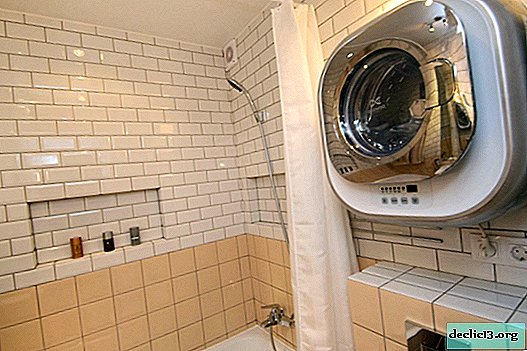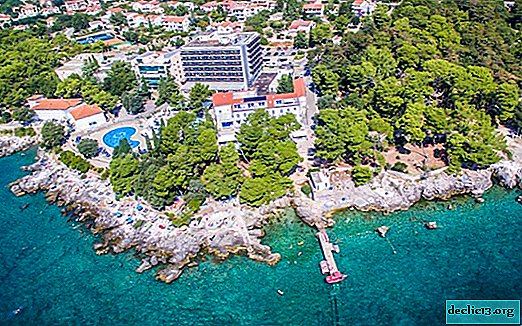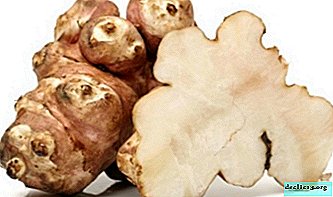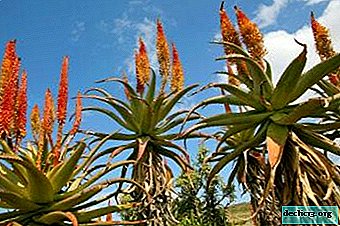We care for echeveria agave in the home correctly
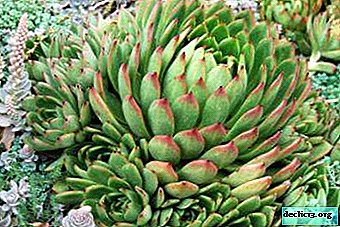
Agave-like echeveria grows rapidly, gets along well with other succulents in rocky compositions, in rockeries, on alpine hills. Often used as an indoor flower.
From the article you will learn about the rules for caring for a flower at home: the optimum temperature for the plant, proper watering, the necessary lighting, how to prune and fertilize, which pot is best to choose.
Also about the methods of its propagation by seeds, leaves and through the tops and rosettes of the plant. What diseases is exposed to echeveria and how to save it from an ailment.
Features of Echeveria agavoides
Echeveria agavoides is the Latin name for the decorative variety of echiveria (we wrote about species and varieties of echeveria here). Grows in a compact bush up to 20 cm tall without a stem.
It features bright green leaves with a reddish fringing at the edges. The leaves are fleshy, dense, wide, pointed at the edges. The sheet plate is oblong, triangular, coated with a glossy coating. Leaves grow up to 7-8 cm in length and 5-6 cm in width.
Rosettes grow symmetrically, spherical, widely deployed, similar in shape to water lilies, up to 15 - 25 cm in diameter. Peduncles are long, up to 30 - 35 cm in height. They grow from the lateral sinuses of the leaves. The flowers are yellow with a reddish tint, collected in numerous inflorescences - umbrellas. The root is superficial, branched.
Home Care
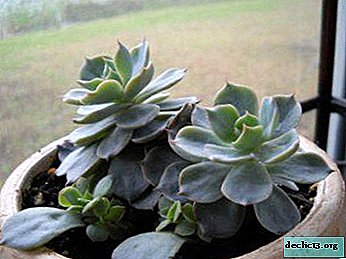 Temperature. The agave-shaped echeveria in the spring - summer period transfers the air temperature to 25 - 28 ºС. In winter, with the onset of the rest period, the optimum winter content is up to 15 ºС. The variety belongs to heat-loving plants, it is not allowed to lower the temperature to 7 - 8 ºС.
Temperature. The agave-shaped echeveria in the spring - summer period transfers the air temperature to 25 - 28 ºС. In winter, with the onset of the rest period, the optimum winter content is up to 15 ºС. The variety belongs to heat-loving plants, it is not allowed to lower the temperature to 7 - 8 ºС.- Watering. The flower does not tolerate overflows and moist soil. It should be watered in small doses in a pan. Between watering, the soil must be dried to 2 - 3 cm of the upper layer. In summer, watering is more intense, 2 to 3 times a month.
During dormancy, watering is minimal, it is enough to moisten the substrate 1 time per month. Do not spray the bushes. Watering should not fall on the leaves and in the middle of the outlet. After irrigation, water should be poured out of the sump so as not to cause excessive moisture in the root system.
- Shine. Agave-like echeveria for full growth and development requires good lighting. Pots should be installed on the south side of the apartment.
During the rest period at a reduced temperature, the duration of daylight hours should be at least 12 hours. Additional lighting with special lamps is required.
Young bushes are required to be shaded from the direct sun in the midday heat. - Pruning. Sanitary pruning of the bush is carried out during transplantation, dry leaves are cut off at the base of the outlet, dry and rotted root processes. After flowering, the flower stalks are cut to the ground. Also, planting outlets are cut off, the lateral processes are children, the elongated tops of the stem. Places of cuts are sprinkled with crushed charcoal or activated carbon.
- Top dressing. Agave-shaped echeveria does not need regular and frequent feeding. The substrate is fertilized in the spring - summer period 1 time in 2 - 3 weeks. Suitable fertilizers for succulents.
In autumn and winter, you should not fertilize the flower. Fertilizers are applied to the wet substrate after irrigation; it is permissible to apply liquid top dressing through irrigation. The dosage and frequency of top dressing should be strictly observed. From an overabundance of minerals, a flower can discard leaves. It is not recommended to use organic fertilizers, it is likely that the substrate is infected with fungal bacteria.
- Pot. Pots and flowerpots are used shallow. For young seedlings, in accordance with the size of the outlet, small pots with a diameter of 6 - 7 cm are used. Adult bushes are transplanted into pots up to 2 l. It is better to use ceramic pots. Ceramics retain the necessary heat, the container does not overheat, and maintains good air permeability.
Before planting the pot should be treated with any disinfectant. Drainage holes are mandatory for the outflow of excess water, periodically they should be cleaned with cotton buds.
Step-by-step instructions for reproduction
Seeds
 The most time-consuming and time consuming method. It is difficult to obtain ripened seeds from hybrid echeveria agave. Seedlings grown through sowing are grown in greenhouse conditions. During flowering, the flowers themselves are artificially pollinated.
The most time-consuming and time consuming method. It is difficult to obtain ripened seeds from hybrid echeveria agave. Seedlings grown through sowing are grown in greenhouse conditions. During flowering, the flowers themselves are artificially pollinated.
The procedure is carried out at the end of February. Seeds are small in structure. The composition of the soil - peat - sand, in a ratio of 1: 1. A drainage layer is required.
Landing pattern:
- Drain and soil are poured into wide shallow containers.
- Seeds are sown on the surface of the soil without deepening.
- Seedlings are lightly sprinkled with soil, the substrate is moistened.
- Sowing containers are covered with a transparent film.The temperature of the crop is 22 - 24 ºС with regular ventilation of the greenhouse. Shoots appear after 2 to 3 weeks.
- Seedlings dive for growing into small pots.
- After the formation of the outlet 3-4 cm, the seedlings are transplanted into permanent containers.
Leaf
This method is convenient, not complicated. For this variety, the method is quite acceptable. The procedure is performed in early spring. The soil should be light, crumbly. The drainage layer consists of perlite, brick chips, polystyrene or expanded clay.
The composition of the substrate for rooting leaves:
- ordinary land;
- well decomposed peat;
- coarse sand.
All components are taken in equal proportions.
Leaf preparation: leaves are cut off from the cut-off outlet so that the base of the sheet is not damaged. With a sharp tool, you must fold the sheet completely.
Leaf sprouting procedure:
- Leaves are laid out in pallets with holes in the bottom.
- The leaves are dried for 2 weeks in a bright room with good ventilation.
- In trays with the finished substrate, the leaves are laid edge-on, the growth point should remain on the surface without deepening. Leaves root for 3 weeks. The development of outlets lasts 1.5 - 2 months.
- Seedlings dive into separate containers with a diameter of 5 cm. Humidity - 30 - 40%. Air temperature - up to 22 ° С. Watering is moderate, as the soil dries.
The whole procedure takes about 2 - 2.5 months.
Watch the video about plant propagation by leaf:
Tops and rosettes
 Agave-like echeveria easily propagates in this way. The flower grows well in diameter, gives a lot of side rosettes - children. The tops forming the central outlet are also cut off. The procedure is carried out in the spring, during active growth..
Agave-like echeveria easily propagates in this way. The flower grows well in diameter, gives a lot of side rosettes - children. The tops forming the central outlet are also cut off. The procedure is carried out in the spring, during active growth..
Before rooting, planting material is dried in a bright warm place for 2 weeks.
Landing pattern:
- The lower leaves are removed from the rosettes, leaving 1 - 2 cm of the stem.
- The stems are buried in a sandy substrate. Rooting takes place within 2-3 weeks.
- Seedlings dive into small pots to grow.
- After a month, young bushes are planted in permanent containers.The air temperature for rooting is at least 20 ° C. Watering is moderate.
Disease
- Agave-shaped echeveria can become ill due to improper watering, a sharp decrease in air temperature, and lack of light.
- Fungal rot of the root, rosettes and stems appear from ingress or stagnation of water. A flower transplant is required, damaged areas are cut out.
- A powdery mealybug may appear from overflow. It is necessary to change the top layer of the substrate, treat the bush with any insecticides.
- From aphids and spider mites, treatment with actellic solution will save. For prevention, once a season, the substrate is treated with fungicide.
5 similar plants
- The agave-like echeveria is similar to the Crassula Red Edge with a reddish edging of the leaves; they differ in the different shape of the leaf plate.
- Kalanchoe paniculata, desert cabbage, has a spectacular reddish edge of pointed leaves.
- Scaphoid haworthia has a dense rosette of pointed leaves. The shape of the bush is similar to an agave-shaped echeveria bush.
- Aloe is multi-leaved. Leaves are tightly assembled in a rosette, growing in a spiral. Pointed tops of leaves of a red tint.
- Scrubs of Weinberg. The Mexican variety has a rosette of leaves in the shape of a flower.
Agave-shaped echeveria is not whimsical at all, easily rooted, grows rapidly, maintains the brightness and freshness of the bush year-round.

 Temperature. The agave-shaped echeveria in the spring - summer period transfers the air temperature to 25 - 28 ºС. In winter, with the onset of the rest period, the optimum winter content is up to 15 ºС. The variety belongs to heat-loving plants, it is not allowed to lower the temperature to 7 - 8 ºС.
Temperature. The agave-shaped echeveria in the spring - summer period transfers the air temperature to 25 - 28 ºС. In winter, with the onset of the rest period, the optimum winter content is up to 15 ºС. The variety belongs to heat-loving plants, it is not allowed to lower the temperature to 7 - 8 ºС.
